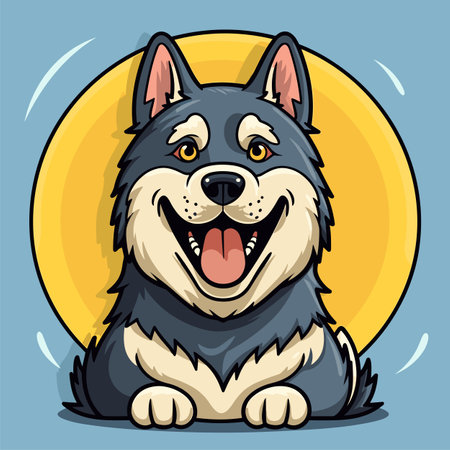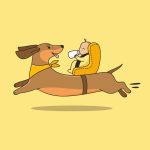1. Understanding Your Dog’s Exercise Needs
Every dog is unique, and their exercise requirements vary based on several factors, including breed, age, and overall health. Ensuring your pup gets the right amount of physical activity is essential for their well-being, helping to prevent obesity, boredom, and behavioral issues.
How Breed Affects Exercise Needs
Different breeds have different energy levels. High-energy breeds like Border Collies or Labrador Retrievers require significantly more exercise compared to lower-energy breeds such as Bulldogs or Basset Hounds.
| Breed Type | Exercise Requirement |
|---|---|
| High-Energy Breeds (e.g., Border Collie, Australian Shepherd) | At least 1-2 hours of vigorous activity daily |
| Moderate-Energy Breeds (e.g., Golden Retriever, Cocker Spaniel) | 45 minutes to 1 hour of moderate exercise daily |
| Low-Energy Breeds (e.g., Bulldog, Shih Tzu) | 30 minutes of light activity daily |
The Role of Age in Exercise Needs
A dogs age also impacts how much exercise they need. Puppies have bursts of energy but tire quickly, while adult dogs require consistent exercise to stay fit. Senior dogs may still enjoy walks but often need a gentler routine.
| Age Group | Recommended Exercise |
|---|---|
| Puppies (under 1 year) | Several short play sessions per day, around 5 minutes per month of age |
| Adult Dogs (1-7 years) | At least 30 minutes to 2 hours depending on breed and health |
| Seniors (7+ years) | Shorter, low-impact activities like gentle walks and light play |
Health Considerations for Exercise
Your dog’s overall health can influence their ability to exercise. Dogs with joint issues, obesity, or respiratory conditions may need modified routines. Always consult your veterinarian if you’re unsure about the best exercise plan for your pet.
Signs Your Dog Might Need More or Less Exercise
- Too Much Exercise: Excessive panting, sore muscles, reluctance to move.
- Too Little Exercise: Weight gain, destructive behavior, excessive barking.
- The Right Amount: Happy demeanor, good appetite, restful sleep.
Finding the Right Balance
The key to keeping your dog happy and healthy is understanding their unique needs. By considering their breed, age, and health status, you can create a routine that keeps them active without overexertion.
Signs Your Dog Needs More or Less Exercise
From restless behavior to excessive sleepiness, discover the warning signs that your dog may not be getting the right amount of exercise. Every dog has unique energy levels, and finding the right balance is key to their overall well-being. Here are some common signs that indicate whether your pup needs more or less physical activity.
Signs Your Dog Needs More Exercise
If your dog isn’t getting enough physical activity, they may start showing behavioral and physical signs of pent-up energy. Here are some indicators:
| Sign | Description |
|---|---|
| Restlessness | Your dog constantly paces, whines, or struggles to settle down, even at night. |
| Destructive Behavior | Chewing furniture, digging holes, or tearing up household items can be a sign of boredom and excess energy. |
| Excessive Barking | Barking at everything—even when there’s no reason—could mean your dog needs an outlet for their energy. |
| Weight Gain | If your dog is gaining weight despite a balanced diet, they might not be burning enough calories through exercise. |
| Poor Sleep Patterns | A lack of exercise can make it hard for dogs to relax and get quality sleep. |
Signs Your Dog May Be Getting Too Much Exercise
While exercise is essential, overdoing it can also cause issues. Watch for these signs that your pup might need more rest:
| Sign | Description |
|---|---|
| Limping or Soreness | If your dog seems stiff, limps, or avoids certain movements, they could be overexerted. |
| Panting Excessively | Panting after activity is normal, but if it continues long after exercise ends, it could indicate exhaustion. |
| Lack of Interest in Exercise | If your normally active dog suddenly resists walks or playtime, they may need a break. |
| Paw Injuries or Worn Pads | Sore paws or worn-down pads from too much running on rough surfaces can signal overexercise. |
| Sleeps More Than Usual | If your dog sleeps excessively and seems sluggish throughout the day, they may be overworked. |
The Right Balance for Your Dogs Health
The key to keeping your dog happy and healthy is finding the right balance between activity and rest. Observe their behavior closely and adjust their routine accordingly. Some dogs thrive on daily long walks and play sessions, while others need shorter bursts of exercise. Paying attention to these signs will help ensure that your pup gets just the right amount of movement every day.

3. Best Types of Exercise for Different Dogs
Not all exercise is created equal. Different breeds and energy levels require different types of activities to stay healthy and happy. Whether you have a high-energy working dog or a laid-back companion pup, finding the right kind of exercise is essential.
High-Energy Breeds
Dogs like Border Collies, Australian Shepherds, and Huskies thrive on intense physical activity. These breeds need more than just a short walk around the block—they require stimulating and physically demanding exercises.
- Running or Jogging: Great for dogs with stamina who love to keep up with their owners.
- Agility Training: Helps with mental stimulation while burning off excess energy.
- Fetch with Distance: Using a ball launcher can maximize movement.
- Hiking: Ideal for adventurous breeds that enjoy exploring nature.
Low-Energy Breeds
Basset Hounds, Bulldogs, and Pugs are known for their lower activity levels. They still need regular movement but in ways that suit their physical limitations.
- Leisurely Walks: A relaxed pace allows them to get fresh air without overexertion.
- Mental Stimulation Games: Puzzle toys can provide engagement without requiring too much movement.
- Short Play Sessions: Light tug-of-war or gentle indoor games work well.
Small Breeds
Toy breeds like Chihuahuas and Dachshunds may not need as much space to exercise but still benefit from daily activity.
- Indoor Playtime: Small dogs can get plenty of movement indoors with toys and games.
- Laps Around the Yard: A fenced-in area is perfect for quick sprints.
- Scent Work: Engaging their nose with hide-and-seek treats keeps them moving and thinking.
Large Breeds
Larger dogs such as Golden Retrievers, Labradors, and Great Danes require consistent movement but also need joint-friendly options due to their size.
- Swimming: A low-impact way to exercise large breeds without stressing joints.
- Nose Work Games: Encourages problem-solving while keeping them engaged.
- Paced Walks or Hikes: Long walks at a steady pace help maintain endurance.
A Quick Look at Exercise Needs by Dog Type
| Dog Type | Best Exercises |
|---|---|
| High-Energy Breeds | Running, agility training, fetch, hiking |
| Low-Energy Breeds | Leisurely walks, mental games, short play sessions |
| Small Breeds | Indoor playtime, yard laps, scent work |
| Large Breeds | Swimming, nose work games, paced walks/hikes |
No matter your dogs size or energy level, finding the right type of exercise ensures they stay healthy and happy. Tailoring activities to their needs will improve their overall well-being while strengthening your bond together.
4. How to Fit Exercise Into Your Daily Routine
Busy schedule? You’re not alone! Finding time for your dog’s exercise can be challenging, but with a little creativity, you can keep your pup active without disrupting your daily routine. Here are some practical ways to make sure your furry friend gets the exercise they need.
Incorporate Walks Into Your Daily Tasks
- Morning Walks: Start your day with a brisk walk. It’s a great way for both you and your dog to wake up and get energized.
- Errand Walks: If possible, bring your dog along when running quick errands, like picking up coffee or dropping off mail.
- Lunch Break Strolls: If you work from home or have a flexible schedule, a short midday walk can break up the day for both of you.
Make Playtime Count
You don’t always need long walks—playing at home can be just as effective! Try these fun activities:
- Tug-of-War: A great indoor game that helps burn energy quickly.
- Fetch: Whether indoors or in the yard, a few rounds of fetch can give your dog a quick workout.
- Hide and Seek: Hide treats or yourself and let your dog sniff you out.
Exercise While You Work Out
If you enjoy staying active, why not include your dog? Here are some exercises you can do together:
| Your Activity | Your Dog’s Activity |
|---|---|
| Jogging or Running | Your dog runs alongside you on a leash. |
| Cycling (for high-energy dogs) | Your dog trots beside you with a hands-free leash attachment. |
| Yoga or Stretching | Your dog joins in with playful movements or rests nearby. |
| Dancing Around the House | Your dog follows along, chasing toys or mimicking your moves. |
Mental Stimulation is Exercise Too!
A tired brain can be just as good as a tired body! Keep your dog engaged with:
- Puzzle Toys: These encourage problem-solving while keeping them busy.
- Nose Work Games: Hide treats around the house and let them sniff them out.
- Training Sessions: Teaching new tricks or reinforcing commands keeps their mind sharp.
The Key is Consistency
No matter how busy life gets, consistency is key. Even short bursts of activity throughout the day add up. Find what works best for your schedule and make it part of your daily routine!
5. Keeping Exercise Safe and Enjoyable
Ensuring your dog gets enough exercise is important, but safety and enjoyment should always come first. Different weather conditions and environments can present challenges, so its essential to adjust activities accordingly.
Exercising in Different Weather Conditions
Hot Weather
Dogs can easily overheat in hot temperatures, so take precautions during warm seasons:
- Exercise during early morning or late evening when its cooler.
- Avoid hot pavement that can burn your dogs paws—test it with your hand before walking.
- Bring water to keep your dog hydrated.
- Watch for signs of heat exhaustion, such as excessive panting or lethargy.
Cold Weather
Some dogs love the cold, while others struggle. Consider these tips:
- Short-haired or small dogs may need a coat or sweater.
- Avoid icy paths where slips and injuries can occur.
- Check paws for ice buildup or irritation from salt on sidewalks.
- If it’s too cold for you, it’s probably too cold for your dog—keep sessions short.
Selecting Safe Environments for Exercise
The right environment makes a big difference in how safe and enjoyable exercise is for your dog.
| Environment | Safety Tips |
|---|---|
| Parks & Open Fields | Ensure the area is pet-friendly and free from hazards like broken glass or toxic plants. |
| Paved Sidewalks | Avoid heavy traffic areas and use a sturdy leash for control. |
| Beaches & Lakes | Not all dogs are natural swimmers—introduce water gradually and avoid strong currents. |
| Dirt Trails & Hiking Paths | Check for ticks after hikes, and bring enough water for both you and your dog. |
Mental Stimulation During Exercise
A good workout isnt just physical—dogs also need mental engagement. Try these ideas:
- Add obedience training into walks by practicing commands like “sit” or “stay.”
- Create an obstacle course using natural objects like logs or benches.
- Toss a ball or frisbee for interactive playtime.
- Scent games, such as hiding treats along the route, keep their nose engaged.
Pacing Exercise Based on Your Dog’s Needs
No two dogs are alike when it comes to energy levels. Adjust activity types and duration based on their breed, age, and health condition:
| Dog Type | Suggested Activity Level |
|---|---|
| Puppies | Short bursts of play; avoid long runs to protect growing joints. |
| Seniors | Mild walks; consider swimming to reduce joint strain. |
| Brachycephalic Breeds (e.g., Bulldogs) | Avoid intense exercise; opt for slow walks in cool weather. |
| High-Energy Breeds (e.g., Border Collies) | An hour or more of vigorous activity like running or agility training daily. |
The Importance of Supervision
No matter where or how youre exercising your dog, always stay attentive. Keep an eye out for signs of fatigue, overheating, or discomfort. With the right precautions, exercise time will be safe, fun, and beneficial for both you and your furry companion!


